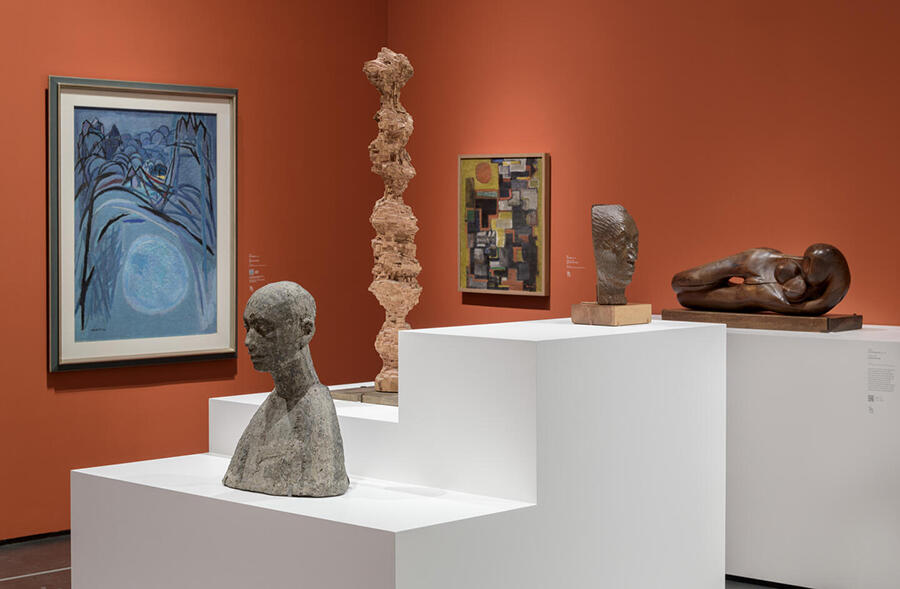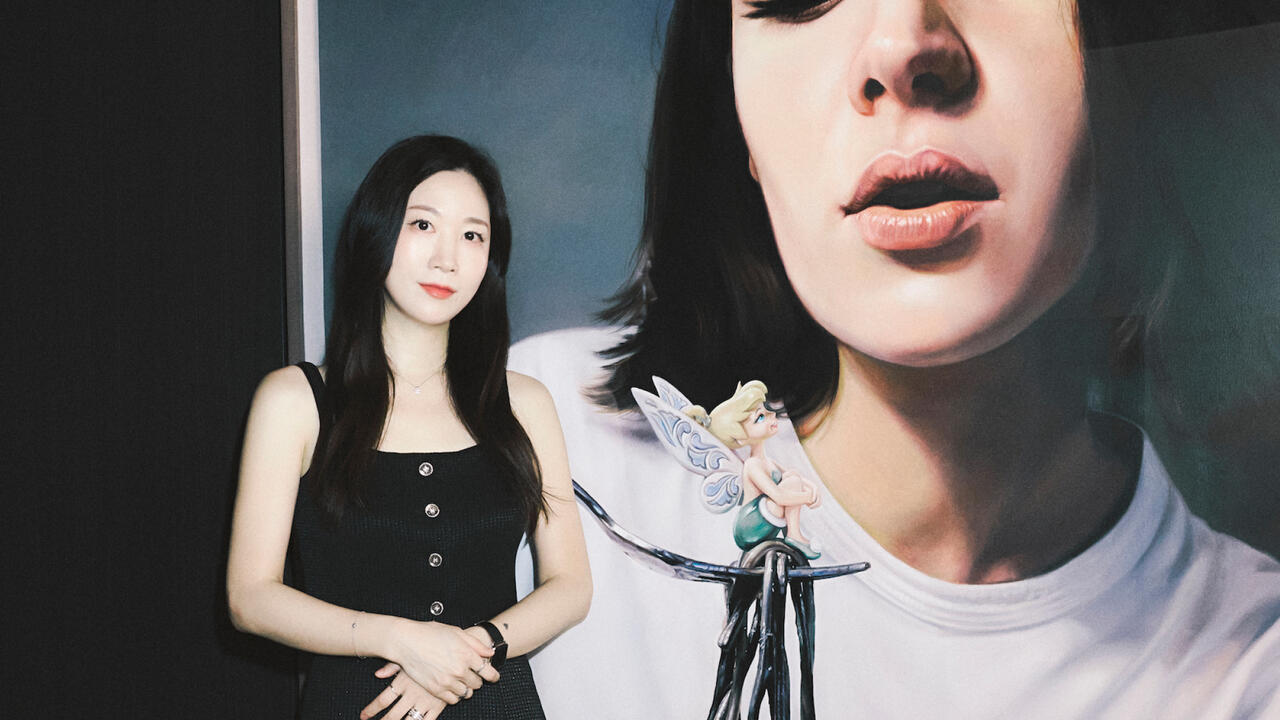Gyopo’s Guide to Four Landmarks of Korean Art on View in Los Angeles
Members of the Los Angeles-based organisation, participating in the fair’s nonprofit platform, navigate shows at LACMA and Craft Contemporary
Members of the Los Angeles-based organisation, participating in the fair’s nonprofit platform, navigate shows at LACMA and Craft Contemporary

Frieze Week is your last chance to visit the landmark exhibition, ‘The Space Between: The Modern in Korean Art’ at Los Angeles County Museum of Art (LACMA). Billed as the ‘first of its kind in the West’, the exhibition presents more than 130 works from a period of great upheaval: from the twilight of the Joseon dynasty through to the bloodshed of the Korean War and the following settlement. The second exhibition organized by LACMA and Hyundai Motor’s Korean Art Scholarship initiative, the exhibition’s curator Dr. Virginia Moon has created a structure across five thematic sections to organize the works of 88 artists. Moon places a special emphasis on the range of media introduced to Korean artists through dialogue with the wider world, from Shin Nakkyun’s photographs of the performer Choi Seunghui to the abstract metal sculptures of John Pai. As a tribute to the growing global presence of K-culture, the audio guide accompanying the exhibition is provided by none other than the icon RM of K-pop group BTS.
Los Angeles is home to the largest Korean community outside of Korea, and to mark the closing of the exhibition, Frieze Week invited members of GYOPO, the LA-based collective of diasporic Korean cultural producers and arts professionals, to select their personal standout works from this historic selection.
Caroline Ellen Liou selects Research (1944) by Lee Yootae

An enigmatic portrait of a woman dressed in a white lab coat, surrounded by the latest scientific equipment: Research (1944) by Lee Yootae at once reveals and confounds the narratives of mid-20th century Korean modernity. The painting mirrors the turmoil of the country at the time, caught as it was between the colonial rule of Japan and the Korean War, struggling throughout to define its own national identity. These conflicting interests are evident in the artist’s nihonga (Japanese painting) style, detailing with laser-sharp precision Western instruments such as the microscope sitting at the center of the composition. The scientist, lost in thought, her expression placid, belies stereotypical images of Asian womanhood. She can neither be read as an idealized symbol of femininity nor as a celebratory version of the modern, liberated woman; instead, she is her own self.
The work is included in the section of the exhibition, ‘The Pageantry of The New Woman (Sinyeoseong) Movement’, which focuses on the history of feminism in Korea. Unsurprisingly, this too was complicated. Sinyeoseong was a product of both foreign influences and domestic impulses, created and promoted by men for women so they could pursue an education. Though the end goal of this movement was meant to enable women to better fulfill their duties as mothers and caregivers, it nevertheless provided a certain amount of agency to the women of Korea at that time. As Research – and the exhibition as a whole – suggests, the process of modernization is never a straightforward read.
Alex Paik selects Artwork (1962) by Quac Insik

Artwork (1962) is a glass pane that the artist, Quac Insik, broke and then carefully reconstructed. Perhaps it is a bit too on the nose to use this piece to talk about the resilience of the Korean people – how they rebuilt a nation and an identity after their language, religion and culture were systematically destroyed by the Japanese; and how, less than a decade after being freed from Japanese rule, Korea was divided into two countries and wracked by a proxy war between the US and Communist superpowers. The period of history that this exhibition focuses on was not only a time of trauma for Korea, it was also a time when Korean artists were heavily influenced by foreign art movements. These artists carry both the historic and artistic fissures that changed their lives and work, and they collectively grapple with the ultimately unresolvable question of what Korean art and identity is.
What I am most interested in is the way Artwork speaks about the formation and instability of identity. Even after the painstaking process of reconstructing the pane, fragment by fragment, the original grid lines never quite line up and the glass still retains the cracks and scars from its initial destruction. What are the scars that remain after breaking and rebuilding a nation? A racial identity? An individual? As reminders of loss and trauma, do the scars become an essentialized part of the identity of a group or individual? While there was a point where the glass did not bear these cracks, it could never be seen outside the interdependent relationships glass has with light and its surrounding environment. By extension, I wonder if a pure platonic Korean identity could ever exist.
Hannah M. Yoo selects Mountain and Moon (1958) by Kim Whanki

The color blue shaped the universe of modern Korean artist Kim Whanki: it was a color full of anguish, affection, devotion and nostalgia for his home country, the glistening sea and clear blue skies of his island hometown in South Jeolla Province. During his years in Paris, from 1956 to 1959, he developed his signature palette and what came to be known as 'Whanki Blue'.
Mountain and Moon (1958) is a wonderful example of Kim’s color. It shows the artist’s proclivity for experimenting with geometric compositional elements, while maintaining a loose interpretive style. Mountains and the moon were motifs at the core of traditional Korean aesthetics, in which Kim rooted his works. The soft, round shape of the moon against the sharp, contrasting peaks of the mountains is highlighted by the vibrant hues of blue, capturing the vitality of nature and the spirit of the Korean landscape.
Kim was a member of the first generation of Korean abstract artists, and played a critical role in establishing a modernist language for painting during his country’s modernization. Like many of his friends, Kim studied in Japan where he encountered European movements such as Cubism and Fauvism. Upon his return to Seoul in 1939, Kim founded an 'avant-garde' group with fellow artists, poets, writers and activists, which sought to redefine traditional Korean aesthetics through abstract art. His interactions with these intellectuals left a profound impression on him that would influence his artistic style in his future works. As artists searched for alternate modes of expressing their identity following the harsh realities of colonialism and war, Kim’s incorporation of Korean motifs and inspiration from nature, painted in his favorite blue, opened a new path for modern Korean art. He was able to reconcile tradition with the modern. Mountain and Moon reflects Kim’s longing for and appreciation of, his roots, and gives profound insight into his identity, as he sought to harmonize the cultural chasm between East and West throughout his nomadic life and artistic journey.
While visiting LACMA, head over Wilshire to see 'Strings of Desire' at Craft Contemporary, a show of 13 artists’ engagements with embroidery exploring non-Western identity, queerness and fantasy.
Lee Painter-Kim on Kang Seung Lee

Kang Seung Lee’s Untitled (Put Badly, Gi Hyeong-do) (2022) floats on the wall. It is a traditional Korean funerary cloth – sambe – a semi-rigid corn-silk-colored woven hemp, with antique 24k gold thread intensively stitched by Lee into American Sign Language (ASL)—specifically, the font used by the late gay Chino-Latino painter Martin Wong. The text is a translation of a poem by revered gay Korean poet Gi Hyeong-Do. Gi passed away in Seoul in 1989 unexpectedly; across the planet in 1993, Wong passed away from AIDS-related causes in San Francisco. Observing this metaphysical conversation, I cannot help but contemplate stigmatized identity within homophobic, conservative late-20th-century Korean and American societies during the AIDS crisis. Is it possible that Lee, Gi and Wong are convening together in this atemporal site of queer Asian histories?
Nearby, Lee’s Untitled (Skin) (2021) raises sambe on a low wooden pedestal holding an expanse of material including fossilized leaves, coprolite and 24k gold thread. The gold embroidery illustrates tattoo imagery sourced from Lee’s queer circle, the gold symbols rhythmically floating across the fabric as echoes of living flesh. The subject of 'skin' as an allusion to kinship identities evokes a Glissantian sentiment on relation and opacity, where queer community is a social weave. It is one that forms a fabric transcending social stigma and time.
Member's of Gyopo are participating in Frieze Week Los Angeles nonprofit platform.
‘The Space Between: The Modern in Korean Art’ is on view at LACMA through February 19
‘Strings of Desire’ is on view at Craft Contemporary through May 7
This article first appeared in Frieze Week, February 2023 under the headline 'Fragment by Fragment: GYOPO’s Responses to a Landmark Display of Korean Art'
Main image: ‘The Space Between: The Modern in Korean Art’, 2022–2023, installation view. Courtesy: © Museum Associates/ LACMA























